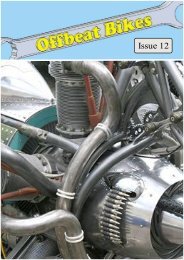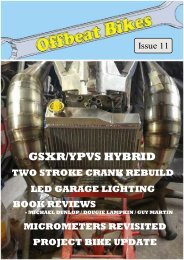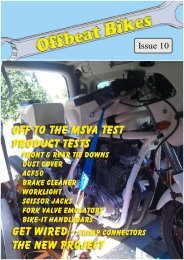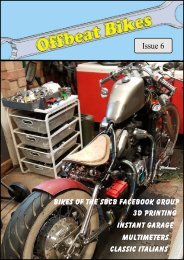Offbeat Bikes Issue 14
Motorcycles of all shapes and sizes!
Motorcycles of all shapes and sizes!
- No tags were found...
You also want an ePaper? Increase the reach of your titles
YUMPU automatically turns print PDFs into web optimized ePapers that Google loves.
<strong>Issue</strong> <strong>14</strong>
Contact:- offbeatbikesmagazine@gmail.com<br />
Website:- offbeatbikesmagazine.co.uk<br />
Facebook:- <strong>Offbeat</strong> <strong>Bikes</strong> Magazine<br />
Hello Everybody,<br />
Welcome to the fourteenth issue of <strong>Offbeat</strong> <strong>Bikes</strong>.<br />
So, similar to the last issue, instead of a large magazine to<br />
download, this smaller issue contains shorter articles with<br />
more expanded versions available on the website. Just click<br />
the relevant links if you want to read more. Hopefully, this<br />
will mean that you can quickly go to the stuff that you’re<br />
most interested in, without having to download the full<br />
magazine.<br />
Summer should be a busy biking season, but we’ve had<br />
some baking hot summer days interspersed with torrential<br />
downpours. A bit hit or miss really, but hopefully you’ve<br />
been out and about. Let’s hope that autumn also brings<br />
some settled riding weather.<br />
Other things that I’ve learnt over the summer? That when<br />
you buy a new project bike, DVLA can send a threatening<br />
letter about impending prosecution because a bike is not<br />
taxed or sorned quicker than they can send you the new V5<br />
to allow you to tax or sorn it!<br />
Next issue will be out at the end of November. Don’t forget<br />
we are always interested in seeing pictures of your bikes,<br />
reports of shows or events that you’ve organised or attended<br />
and if you run a bike related business, we are only too happy<br />
to do a feature on it.
Fe O - FO !<br />
2 3<br />
. ff<br />
Iron oxide, rust, call it what you like, it’s usually an unwanted<br />
addition to most motorcycles. There are many methods of<br />
removing it, but some of the easiest are liquid rust removers.<br />
Providing the part is either small enough to submerge, or be<br />
filled with the solution, you can then walk away and let the<br />
chemicals do their thing. The popular liquid at the moment is<br />
distilled vinegar. I hadn’t tried vinegar before, but I have used a<br />
couple of commercial products. So it seemed only right to try a<br />
little test of the three liquids.<br />
Now, before we start, the Metal Rescue used in the test I have<br />
had for many years. It’s been well used and is now a long way<br />
past its best. If I was using fresh product (it’s a big if, I’m<br />
working on the assumption that the current formulation of<br />
Metal Rescue is as good as the old version) then from my<br />
previous experience of using the product, it would have won<br />
this test. Here, though, is a summary of my current findings so<br />
far:<br />
Three rusty scraps of steel. These have been sat<br />
outside for at least a year and are fairly scabby!
ABOVE: Start of the test. From L to R: Vinegar, Metal<br />
Rescue, Hammerite Rust Remover Dip<br />
BELOW: After 17 hours, none have removed the rust<br />
completely, but the Hammerite is best so far.<br />
After 17 hours, the Hammerite is doing<br />
the best job with vinegar next and the worn<br />
out Metal Rescue struggling to make an<br />
impact.<br />
THE TEST<br />
CONTINUES ON<br />
THE WEBSITE.<br />
CLICK TO VIEW.
PRICE COMPARISON<br />
£10.20 for 500ml<br />
from Halfords.<br />
Dilute with water<br />
to make 5 litres of<br />
rust remover dip.<br />
Around £32<br />
delivered from<br />
Ebay. 4<strong>14</strong>ml,<br />
dilutes to make<br />
3.78 litres.<br />
29p for 568ml<br />
from ASDA or<br />
free if you find<br />
some in the<br />
kitchen<br />
cupboard!
Plastic Fantastic<br />
When I tell people that the<br />
tank cover on my bike is<br />
fibreglass and not hand<br />
beaten from sheet metal,<br />
they seem to dismiss it, as if<br />
somehow it’s an easy option.<br />
If they had been involved in<br />
its construction, they may<br />
well have a very different<br />
view on it!<br />
Yes, the resin and<br />
fibreglass mat may not<br />
require much skill to mix<br />
and lay, and the materials<br />
I believe that you can never<br />
own too many books, tools or<br />
motorcycles, so given that, it<br />
should be no surprise that I<br />
own three books on using<br />
fibreglass - and one DVD.<br />
The smallest tome is ‘The<br />
Glassfibre Handbook’ by R<br />
H Waring (ISBN: 978-085242-<br />
820-7 around £8 new, half that<br />
for a secondhand copy)<br />
This is a comprehensive<br />
book, but it isn’t an in depth<br />
book. It’s great for an overview<br />
used in making the pattern<br />
may be easily worked with<br />
standard hand tools, but<br />
unless you’re making a<br />
straight sided box, you still<br />
need to have some pretty<br />
good sculpting skills. So, it’s<br />
not really an easy option,<br />
but it is an easily accessible<br />
option and if you’re<br />
interested in finding out<br />
more, here’s a short review<br />
of some books on the matter.<br />
More detail on the website.<br />
of the subject or as a reference<br />
book if you’ve done some<br />
GRP work before, but need a<br />
reminder. It gives a little bit of<br />
information about a wide range<br />
of GRP related issues, and so<br />
is great for giving you ideas of<br />
the types of things you can do<br />
and the ways they can be<br />
achieved, but if you’re really<br />
new to fibreglass work you<br />
might need another source of<br />
information to help you on<br />
your way.
‘Competition Car<br />
Composites’ by Simon<br />
McBeath (ISBN:<br />
9781859606247<br />
around £8 secondhand<br />
for the old edition as<br />
pictured. The newer<br />
edition can be<br />
purchased for around<br />
£20)<br />
Ignore the car<br />
reference in the title,<br />
much of the information<br />
contained is equally applicable<br />
to bike stuff. Simon writes<br />
from his own experience,<br />
working in a small shed,<br />
producing products for his<br />
own use - much like most of<br />
us. He has, however,<br />
thoroughly researched the<br />
subject and has been able to<br />
present it in such a way that as<br />
well as being an informative<br />
book, it is also a very readable<br />
book.<br />
It assumes no prior<br />
knowledge of composite<br />
materials and leads you<br />
through all the steps needed<br />
for you to successfully<br />
produce your own mouldings.<br />
It also discusses the use of<br />
material upgrades, carbon fibre<br />
etc. It doesn’t, however, cover<br />
repair of existing GRP<br />
components, so you’d need to<br />
look elsewhere for that kind of<br />
information.<br />
Finally, on the book front I<br />
have ‘The Fibreglass<br />
Manual’ by Keith Noakes<br />
(ISBN: 1-86126-575-1 around<br />
£5 secondhand) If I didn’t<br />
have this book, I wouldn’t<br />
miss it. Not because it is bad,<br />
it’s a reasonable book on the<br />
subject, but the previous two<br />
are much better.<br />
For a review of the DVD and<br />
some useful online resources<br />
click HERE
Pattern Making FOR GRP<br />
Unless you’re making a flat<br />
side panel, most motorcycle<br />
parts have nasty complex<br />
curves which are difficult to<br />
reproduce. You end up with<br />
four main options:<br />
1) Loads of car body filler,<br />
built up and sanded to shape.<br />
2) Moulding wax.<br />
3) Chavant clay<br />
4) 3D Printing<br />
5) Foam<br />
Number one is fairly cheap,<br />
but quite hard work. Lots of<br />
sanding. Lots of dust. Numbers<br />
two and three are easily<br />
worked, easy to add and<br />
remove material, but it’s quite<br />
difficult to get a fine surface<br />
finish, and it would be<br />
expensive if you’re making<br />
something large. (Although,<br />
only the top layer needs to be<br />
wax or clay, you could use<br />
anything you want to provide<br />
the rough shape underneath.)<br />
Number 4 only works if you<br />
have access to a 3D printer<br />
and are good at drawing stuff<br />
More on Chavant clay<br />
and moulding wax<br />
HERE.<br />
Extruded polystyrene foam. Easy<br />
to shape and inexpensive to buy,<br />
but is it the best choice?
using 3D CAD.<br />
That leaves us with number<br />
5, foam. Here again you have a<br />
choice, the easiest (and<br />
cheapest) to obtain is extruded<br />
polystyrene (often called<br />
Styrofoam). It’s used as<br />
insulation in the building<br />
trade, so it’s usually easy to<br />
find. The other type of foam<br />
often used for pattern making<br />
is polyurethane. This is less<br />
common to find (you’ll<br />
probably have to get it from a<br />
specialist supplier) and it is<br />
much more expensive. Both<br />
types of foam are easy to cut<br />
and shape, but in order to<br />
make a useable pattern, you<br />
will need to apply some kind<br />
of top layer that can be sanded<br />
to a fine finish. (The foam is<br />
also easily damaged, so a top<br />
layer is also desirable to make<br />
the pattern more robust.)<br />
Choices of top layer include<br />
car body filler, paint or<br />
laminating resin. Here’s where<br />
more even problems are<br />
encountered. Polystyrene foam<br />
is attacked by the solvents in<br />
many paints, body filler and<br />
polyester laminating resins!<br />
(See pic. below). The easy<br />
ways around this? Use the<br />
expensive polyurethane foam,<br />
or coat polystyrene foam with<br />
(expensive) epoxy laminating<br />
resin. For the cheaper, but<br />
more time consuming, way<br />
around this, CLICK through to<br />
the article on the website.<br />
Polystyrene test pieces coated with various<br />
different top layers. Click HERE for a more in<br />
depth discussion of the options.
euston rural Pastimes 2019<br />
Not strictly a bike show, but<br />
the rural pastimes event<br />
usually attracts a good array of<br />
bikes (plus many more cars,<br />
stationary engines, tractors<br />
etc.) although this year’s<br />
weather meant that numbers<br />
were down on previous years.<br />
These were my favourites of<br />
the day.<br />
Click HERE for<br />
more pictures.<br />
1955 Panther Model 65
1952 BOWN 1F<br />
Nice to see a CX500 and Superdream<br />
in unmolested standard condition.
Luca’s Cafe Racer build has been featured before in the<br />
magazine (starting way back in issue 5, I think). Like most of us,<br />
he’s found that building a bike takes way longer than you think.<br />
But, he’s kept at it and the finish is getting ever closer and I<br />
definitely think it’ll be worth the wait. Here are a couple of his<br />
latest pictures. More pictures and details of the build are now in<br />
the gallery section of the website.<br />
More pictures on<br />
the website.<br />
HERE
Shed Alarm<br />
Cheap Ebay<br />
shead alarm.<br />
Is it a bargain<br />
or b*llocks?<br />
After the recent thunder<br />
storms fried the control panel<br />
to the burglar alarm system, it<br />
was disappointing to find out<br />
that spares for the 17 year old<br />
system weren’t available - it<br />
seems that like most things<br />
nowadays, alarm systems have<br />
gone wireless. My wired<br />
system is now virtually<br />
obsolete.<br />
As a stop-gap, £5.50 was<br />
invested in this keypad alarm<br />
system from ebay. It’s a simple<br />
device, wired to one magnetic<br />
switch with about 6 inches of<br />
cable, so you’d need to mount<br />
it very close to the door /<br />
window etc., which is<br />
probably its biggest downfall -<br />
if said burglar triggers the<br />
alarm, one hefty whack would<br />
probably silence the thing (it’s<br />
not the most robust device.)<br />
and it wouldn’t be too hard for<br />
him to find, given that it’s<br />
mounted right next to the door<br />
that he’s just come through.<br />
However, it’s not completely<br />
useless. Cutting the fitted door<br />
switch off and wiring my<br />
existing magnetic switches (in
series) to the unit revealed that<br />
the unit would work with<br />
these. So as a temporary stop<br />
gap, it’s not so bad. And, using<br />
the longer cables of the<br />
existing switches meant that<br />
the control panel could be<br />
mounted further from the<br />
point of entry. So at least<br />
they’ll have to try and find the<br />
unit to smash it.<br />
There are still a couple of<br />
downsides. It’s battery<br />
operated and I don’t know<br />
what the battery life will be<br />
like. And the sounder is not<br />
that loud. If the unit is in your<br />
shed, some way from the<br />
house, then you may not hear<br />
it, unless you’re a light<br />
sleeper! If your shed / garage is<br />
close to your house (so that<br />
you could have the unit<br />
indoors and extend the cable<br />
to the magnetic switch) it<br />
would be more useful. That<br />
way, it’d be harder for the<br />
intruder to sabotage the unit<br />
and you’d be more likely to<br />
hear the alarm.<br />
So, in summary, it’s not that<br />
great, but it only cost £5.50<br />
(delivered!) so it isn’t going to<br />
break the bank. And, if you<br />
can work it so that the unit is<br />
inside the house, it might<br />
prove to be a cheap bit of extra<br />
security. The big problem with<br />
the unit I have is… that you<br />
can’t rely on it to actually<br />
work every time. Which is<br />
bloody annoying!<br />
BIKES AT THE SHUTTLEWORTH<br />
COLLECTION
Better known for their collection of vintage aircraft, The<br />
Shuttleworth Collection at Old Warden, Bedfordshire also has<br />
a fair few road vehicles, including a selection of motorcycles.<br />
Here’s a couple of flat tankers to whet your appetite.<br />
ABOVE: 1924<br />
Sunbeam Model 2<br />
BELOW: 1904<br />
AURORA<br />
CLICK FOR<br />
MORE PICS
Fancy a flattanker<br />
but don’t<br />
want to build<br />
your own. Or<br />
fancy a flattanker,<br />
but want<br />
something more<br />
reliable than a<br />
pre-war<br />
motorcycle? Well now you can buy a brand new one.<br />
The revival of the Wardill Motorcycle marque (by a<br />
descendant of the original company, no less) brings a brand<br />
spanky new flat-tanker to the market. The Wardill 4 prototype<br />
is pictured below, with the first production model currently<br />
under construction. Visit their website for more details.<br />
https://wardillmotorcycles.com/the-wardill-4/<br />
The Wardill 4 prototype.<br />
Photo courtesy Wardill Motorcycles
A brief round up of our latest project<br />
In case you’ve forgotten,<br />
here’s a brief recap of the<br />
latest project.<br />
The idea is to build a classic<br />
(late 1970s) inspired dirt bike<br />
using the rolling chassis from<br />
a 1996 YZ125 and the 230cc<br />
fourstroke engine from a<br />
Chinese supermoto. It also<br />
needs to be low enough to<br />
accommodate my short legs,<br />
and be built to MSVA regs to<br />
allow it to go on the road.<br />
What’s been going on since<br />
May?<br />
Well, it’s mostly been about<br />
bodywork; seat base,<br />
mudguards and petrol tank.<br />
Seat base has been made in<br />
fibreglass, using a modified<br />
original as a pattern. The rear<br />
mudguard is also GRP using<br />
two existing mudguards to<br />
provide the pattern And the<br />
front mudguard - I bought<br />
that one!<br />
Want to see more on this<br />
project? Follow its progress<br />
each week on FACEBOOK,<br />
or catch up with it on the<br />
WEBSITE
In the last issue, we also<br />
reviewed a hot stapler. It’s<br />
been in use again since then<br />
repairing the airbox of the<br />
YZ125 donor bike. Although<br />
this airbox is not going to be<br />
used in its current form, I do<br />
want to use it as part of a<br />
pattern. It had been broken for<br />
some time and was held<br />
together with large quantities<br />
of tape. A few minutes with<br />
the hot stapler made the tape<br />
redundant. Unfortunately, the<br />
picture isn’t very clear. You<br />
have to look hard to see the<br />
staples. The inset picture<br />
shows a close up view of one<br />
of the staples. The staples<br />
haven’t been trimmed and no<br />
tidying of the melted areas has<br />
been done as the inside surface<br />
doesn’t matter for pattern use.<br />
I can tell you that the repair is<br />
far firmer than I expected.<br />
If you missed the article on<br />
the hot stapler in the last<br />
issue, find it HERE.
















